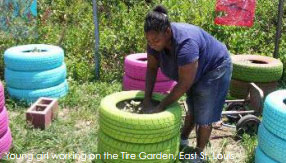Establish a Community Garden or Local Food Installation
Information and resources on establishing a community garden or food installation.
Description

A community garden is most often a single piece of land, tended collectively by a group of people to grow herbs, vegetables, fruits, flowers, shrubs, and trees. A local food installation is a smaller and more tactical method of growing food in your neighborhood that can be implemented if a community garden is not feasible. These projects are smaller and either in the public right of way or on private property. Some examples include the Fruit Fence, a Roof Top Garden.
Related Tools
When paired with other tools, this strategy can make an even greater and more holistic move toward sustainability in your neighborhood. Think about garden to table programs, healthy cooking and eating courses, local restaurants, farmers markets, and youth and seniors programs to create a larger positive impact. Try combining this tool with:
Community Projects
Add your project
Neighborhood Benefits
Environmental
- Improved biodiversity, local habitat, soil quality, and neighborhood greening
- Reduced stormwater runoff
- Reduced waste from food purchasing and transportation
- Reused and cleaned abandoned properties
Social
- Increased access to healthy, nutritious, and local food
- Engaged, active, and healthier neighbors
- Educational opportunities
- Reduced crime
- Encouraged inter-generational relationships
Economic
- Reliable source of local food and increased food independence
- Improved and stabilized property values
- Food can be sold at local restaurants or farmers markets
Get Started
- Resources For how to create a community garden in St. Louis visit the websites Missouri Botanical Garden, American Community Gardening Association, the EPA, Missouri Extension, and Gateway Greening.
- Choose a Location Find and secure a site for your garden or installation. Go by foot or by bike to see which site suits your needs. Consider who owns the land, such as the City of St. Louis Land Reutilization Authority (LRA) (which leases land for $1 for urban gardens), churches, non-profit organizations, or businesses;these groups may be able to sell, rent, or donate land or may want to be a partner in your garden or installation. Consider site conditions and soil quality to inform clean up or prep work that may be necessary. Tips can be found at Gateway Greening and the EPA. Consider access to sunlight and water - you can get access to water by talking to an Alderman, Block Captain, or NSO, or applying to the City of St. Louis for a grant to get water access.
- Budget Identify resources needed to start your garden or installation. This includes design and construction costs, site clean up costs, tools, infrastructure (such as a water source), equipment, plants, and seeds. Information on additional funding, tools, learning materials, plants, or seeds is at Gateway Greening and Missouri Botanical Garden.
- Plan Design the garden. Accommodate children, the elderly, and people of all abilities. Raised beds, wider paths, and benches can be used to create a more usable space. Ensure safety and security in your garden as well (tips can be found through Missouri Extension). Create a planting, care, and maintenance plan that meets the needs of all your neighbors. Identify resources for acquiring plants through any of the above resources, including Gateway Greening.
- Organize Develop the garden membership structure. Decide whether and how many beds are available, how they will be assigned, and how the garden will be managed overall. Identify space for storing tools, making compost, and pathways. Plant flowers or shrubs around the garden's edges to promote good will with non-gardening neighbors, passersby and municipal authorities. Create clear Gardener Guidelines, Garden Rules, or Contract in writing. Work with your planning group to revise and refine your guidelines. Look at Missouri Extension for a good list of issues to consider.
- Gather Support Build community support with ongoing community meetings or events to get the participation and investment of your neighbors.
- Construct Build the garden or installation. This usually takes place over a few regularly scheduled workdays. It is helpful if one or more people can lead various projects and coordinate equipment, supplies, and volunteers.
- Share Determine how the products of the garden will be distributed. Will they be divided equally? Will each grower eat their own? Will any be sold at market or to other neighbors?
- Participation Ensure ongoing participation and communication. Create a bulletin board, mailer, phone tree, email list, or website for sharing information, events, tips, and ongoing maintenance for your garden or installation.
Related Categories
Sustainability Plan Categories
Project Scale
- Block
- Neighborhood
- Private Site
Download This Tool
Establish a Community Garden or Local Food Installation Doc (440.29 KB pdf)
Need Help Viewing?
You need a program that can open Adobe PDF files. A free option:
- Adobe Reader can read PDF files
Help Us Improve This Page
Did you notice an error? Is there information that you expected to find on this page, but didn't? Let us know below, and we'll work on it.
Feedback is anonymous.